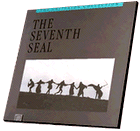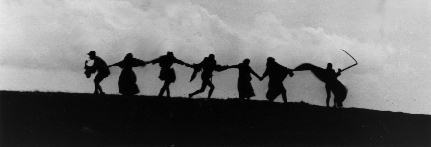

Sweden film school
1957
bw 96 min.
Director: Ingmar Bergman
CAV: out-of-print collectible
2 discs, catalog # CC1110L
CLV: $49.95 - available
1 disc, catalog # CC1212L
DVD: $39.95 - taking pre-orders now
1 disc, catalog # SEV100
VHS: available from Home Vision Cinema

For thirty
years, The Seventh Seal has been a benchmark by which all other
great foreign films are judged. It launched the international career
of its director, Ingmar Bergman, and made a star of its 27-year-old
leading actor, Max von Sydow. The Seventh Seal and the other
Bergman masterpieces that soon followed it -- Wild
Strawberries, The Magician, and The Virgin Spring --
were as important to the development of world cinema as the New Wave
in France or the work of Fellini, Antonioni and Bertolucci in
Italy. Bergman's work proved that essential philosphical and human
issues could be explored on film and still reach a wide
audience.
The miracle is that Bergman's genius enabled him to
reflect the trepidation of the Cold War era and yet also transcend it,
so that The Seventh Seal continues to enthrall each new
generation with its complex investigation of love, selfsacrifice, and
the problems of pain and death.
At first glance, the film would
appear insufferable. It is set in the Middle Ages at a time when the
Plague was ravaging Europe, orthodox religion was locked in the battle
with paganism and the disillusionment brought about by the Crusades,
and it describes a Knight's doomed attempt to forestall death. Yet
nearly everyone who sees The Seventh Seal emerges stunned and
thrilled by its visual splendors, and inspired by one or other of the
major characters.
The Seventh Seal takes its title from the
Book of Revelations, and in 1956 the threat of Apocalypse seemed as
palpable as it must have been in medieval Sweden. Yet Bergman refuses
to succumb to the pessimism that pervades all those about him; he
identifies now with the zealous knight, now with his cynical
squire. His characters manage to overcome the fear of Death, rather
than the fact of Death, and if, as the knight discovers, one can
achieve even a single gesture of goodwill, then the long struggle of
life will be justified.
The 1950s was Bergman's most fruitful
decade. He made The Seventh Seal while attached to the Malm
Municipal Theater in southern Sweden. It was a hectic round of
stagework in winter, and filmmaking in summer. Bergman used the same
loyal troupe of performers and technicians from film to film and from
play to play. The Seventh Seal itself grew out of a short
morality play Bergman had written during the early 1950s, but such is
his imaginative use of real locations, and so fluent his montage, that
any notion of theatricality is banished from the screen. The film
abounds with images that have become instantly recognizable emblems of
world cinema -- the Knight Antonius Block confronting Death across a
chessboard, the procession of the flagellants, or the "Dance of Death"
against the louring skyline in the final moments.
For all its
richly embroidered dialogue, The Seventh Seal remains a
personal film in the profoundest sense of the term. Bergman is
exorcising his own demons, his own dread of the eternal darkness, and
to his surprise and delight this process has appealed to audiences in
practically every corner of the world. It is as thought for the first
time in the movies someone had dared to ask in public those most
intimate and basic questions that each of us ask in private; to
illustrate and analyze on screen the doubts and fears, yearnings and
aspirations, for which most filmmakers cannot find a visual
language. And by couching his drama in an historical framework,
Bergman has ensured that it does not date.
Made with a tiny crew on
a modest budget, in a mere 35 days of shooting, The Seventh
Seal breathes an extraordinary authenticity. We instantly believe
in the medieval mood, and we accept the young Max von Sydow as a
white-haired, world-weary survivor of the Crusades. P. A. Lundgren's
set designs mirror the frescoes that as a boy Bergman used to gaze at
when visiting local churches with his father. Erik Nordgren's music
score echoes the fierce, unsettling beauty of Carl Orff's Carmina
Burana. Above all, the cinematography of Gunner Fischer (who worked on
all the great early Bergman films) invests each image, each sequence,
with a crystalline depth and detail. Apart from Gregg Toland and
Bergman's own subsequent collaborator Sven Nykvist, nobody has matched
the luminous, almost hallucinatory brilliance of Fischer's lighting on
The Seventh Seal.
Scrutiny of the film reveals just how
meticulous is Bergman's balance of the somber and the carefree, the
harsh and the satirical. Each encounter with Death gives way to an
earthy, humorous episode. And just when we feel it safe to accept the
relaxed banter between, for example, the squire and the blacksmith,
Bergman seizes us by the throat with savage glee and plunges us into
the heart of darkness, as a monk harangues the penitents, or as a
young girl is put to the stake in a forest clearing.
This superb
copy of The Seventh Seal enables us to relish the film as it
looked in 1957, and to marvel even more at Bergman's loving attention
to every composition, every cut, and the structure of each
sequence.
The Seventh Seal throbs and reverberates with
intelligence and emotion as perhaps no other European film has done in
the intervening years. It remains Bergman's great trail-blazing
masterpiece, his Hamlet, his Faust.
-- PETER
COWIE
Credits
Director: Ingmar Bergman
Scenario:
Ingmar Bergman
Photography: Gunnar Fischer
Editor: Lennart
Wallen
Music: Erik Nordgren
Sets: P.A. Lundgren
Producer:
Allan Ekelund
Assistant Director: Lennart
Ohlsson
Transfer
This edition of The Seventh Seal
was transferred from a 35mm master print.







